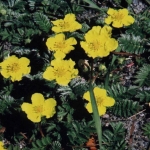

| Silverweed is most often found in sandy or gravelly soils, where it may spread rapidly by its prolific rooting stolons. It typically occurs in inland habitats, unlike A. egedii, which is a salt-tolerant coastal salt marsh plant. | |||||||||||
| Herbal tea from the underground roots is used to help delivery, and as antispasmodic for diarrhea. The plant was also put in shoes to absorb sweat. It was formerly believed to be useful for epilepsy, and that it could ward off witches and evil spirits. Argentina anserina herb has been used in the traditional Austrian medicine internally as tea for treatment of disorders of the gastrointestinal tract, gynaecological problems, and spasm. The plant has been cultivated as a food crop for its edible roots. The usual wild forms, however, are impractical for this use, as they are small and are hard to clean. It may also become a problem weed in gardens. Travelers visiting Tibet reported on the food use of the plant's root in the region. According to Pyotr Kozlov, who traveled in the Kham region in 1900-1901, Tibetans, who did not have any vegetables other than turnips, would often dig out roots of Argentina anserina (whose local name he gave as djüma), which could be easily dried and stored for later use. Kozlov even suggested that it would not be a bad idea for Russian peasants to do likewise, especially in famine years. The mission of Sarat Chandra Das to Tibet in the late nineteenth century reported that the root of the plant, under a Tibetan name variously transcribed as toma, doma or droma, was served cooked in butter and sugar at the New Year's celebrations in the Tibetan capital Lhasa. | |||||||||||
| The pre-Linnaean name anserina means "of the goose" (Anser), either because the plant was used to feed them or because the leaves reminded of the bird's footmarks. In Sweden, the flower is called gâsört (goose-wort) A rich folklore has developed around Silverweed. The plant bears the common name of richette in French, being rich through both silver and gold. There is a legend that the Christ Child grew up and walked the roads of Palestine; and the yellow flowering plant of the dusty wayside with silvery fern-like leaves that lay flat on the ground has been called the Footsteps of Our Lord. |
|||||||||||
|
|
|||||||||||
|
|
|||||||||||
|
|
|||||||||||
|
Don't take if you:
Consult your doctor if you: Pregnancy: Dangers outweigh any possible benefits. Don't use. Breastfeeding: Dangers outweigh any possible benefits. Don't use. Infants and Children: Treating infants and children under 2 with any herbal preparation is hazardous Others: None are expected if you are beyond childhood, under 45, not pregnant, basically healthy, take it only for a short time and do not exceed manufacturer's recommended dose. Storage: Safe Dosage: Consult your doctor for the appropriate dose for your condition. |
|||||||||||
|
|||||||||||
Vitamins, Herbs, Minerals & amp; Supplements The Complete Guide by H. Winter Griffith, MD Copyright©1998 Fisher Books pp 436-437 |
|||||||||||